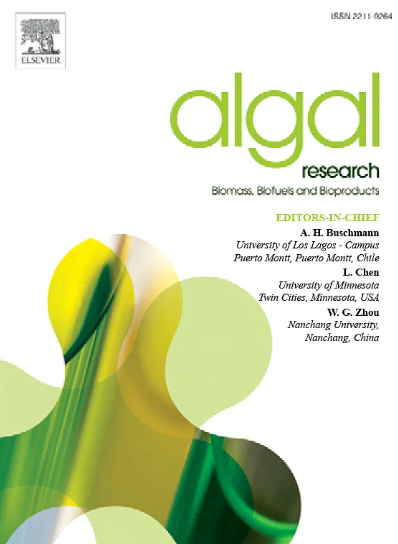Ethanol-driven mixotrophic cultivation enhances biomass production and CO2 capture in Euglena gracilis for sustainable bioresource utilisation
IF 4.6
2区 生物学
Q1 BIOTECHNOLOGY & APPLIED MICROBIOLOGY
Algal Research-Biomass Biofuels and Bioproducts
Pub Date : 2025-06-16
DOI:10.1016/j.algal.2025.104148
引用次数: 0
Abstract
This study explored the enhancement of biomass production and CO2 capture in Euglena gracilis through mixotrophic cultivation using ethanol as a high redox potential substrate. Three cultivation strategies were compared: photoautotrophic, heterotrophic, and mixotrophic. The mixotrophic condition yielded the highest biomass production at 1.79 g L−1, markedly exceeding the yields observed in heterotrophic (0.84 g L−1) and photoautotrophic (0.11 g L−1) cultures. Although ethanol consumption was comparable between mixotrophic and heterotrophic conditions, the presence of light in the mixotrophic system appeared to enhance cellular metabolism, presumably by improving cellular energy availability. This led to greater biomass production and CO2 fixation. Correspondingly, the mixotrophic culture achieved a CO2 capture rate of 0.07 g CO2 L−1 day−1, representing a 600 % increase compared to the 0.01 g CO2 L−1 day−1 observed under photoautotrophic conditions, and exhibited a higher total carbon content in the biomass (41 % versus 28.9 %). These findings provide a proof-of-concept for using ethanol-supplemented mixotrophic cultivation to significantly boost both biomass production and CO2 capture in E. gracilis, underscoring its potential for applications in carbon capture and sustainable biomass production.
乙醇驱动的混合营养栽培提高了叶茅的生物量生产和二氧化碳捕获,促进了生物资源的可持续利用
本研究探讨了乙醇作为高氧化还原电位底物,通过混合营养培养提高粗叶草生物量产量和CO2捕集。比较了三种培养策略:光自养、异养和混合养。混合营养条件下的生物量产量最高,为1.79 g L−1,明显超过异养(0.84 g L−1)和光自养(0.11 g L−1)培养的产量。虽然混合营养和异养条件下的乙醇消耗量相当,但混合营养系统中光的存在似乎通过提高细胞能量利用率来增强细胞代谢。这导致了更大的生物量生产和二氧化碳固定。相应地,混合营养培养的CO2捕获率为0.07 g CO2 L−1 day−1,与光自养条件下观察到的0.01 g CO2 L−1 day−1相比,增加了600%,并且生物质中总碳含量更高(41%比28.9%)。这些研究结果为利用乙醇补充的混合营养栽培显著提高薄叶菊的生物质产量和二氧化碳捕获提供了概念证明,强调了其在碳捕获和可持续生物质生产方面的应用潜力。
本文章由计算机程序翻译,如有差异,请以英文原文为准。
求助全文
约1分钟内获得全文
求助全文
来源期刊

Algal Research-Biomass Biofuels and Bioproducts
BIOTECHNOLOGY & APPLIED MICROBIOLOGY-
CiteScore
9.40
自引率
7.80%
发文量
332
期刊介绍:
Algal Research is an international phycology journal covering all areas of emerging technologies in algae biology, biomass production, cultivation, harvesting, extraction, bioproducts, biorefinery, engineering, and econometrics. Algae is defined to include cyanobacteria, microalgae, and protists and symbionts of interest in biotechnology. The journal publishes original research and reviews for the following scope: algal biology, including but not exclusive to: phylogeny, biodiversity, molecular traits, metabolic regulation, and genetic engineering, algal cultivation, e.g. phototrophic systems, heterotrophic systems, and mixotrophic systems, algal harvesting and extraction systems, biotechnology to convert algal biomass and components into biofuels and bioproducts, e.g., nutraceuticals, pharmaceuticals, animal feed, plastics, etc. algal products and their economic assessment
 求助内容:
求助内容: 应助结果提醒方式:
应助结果提醒方式:


